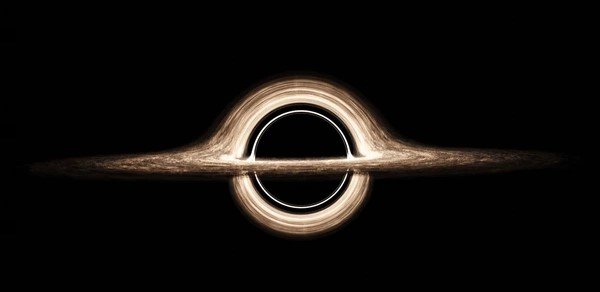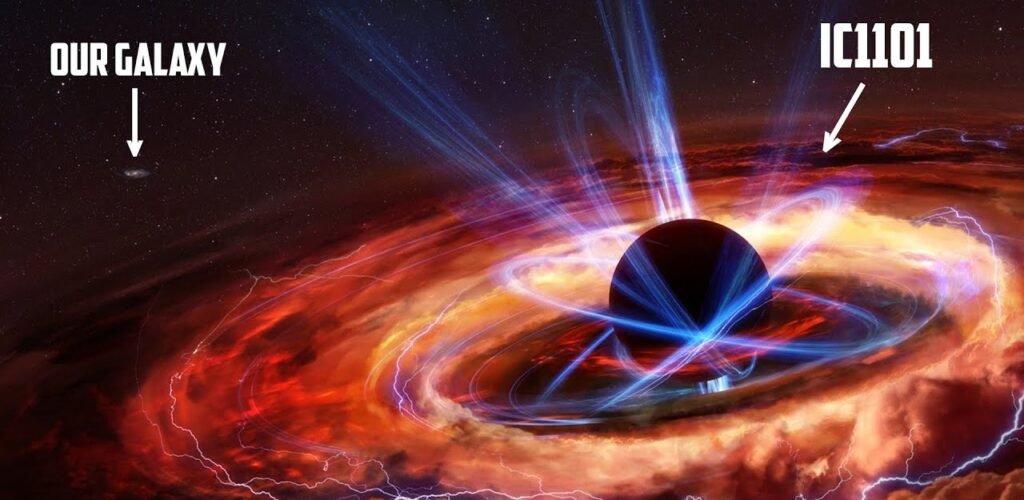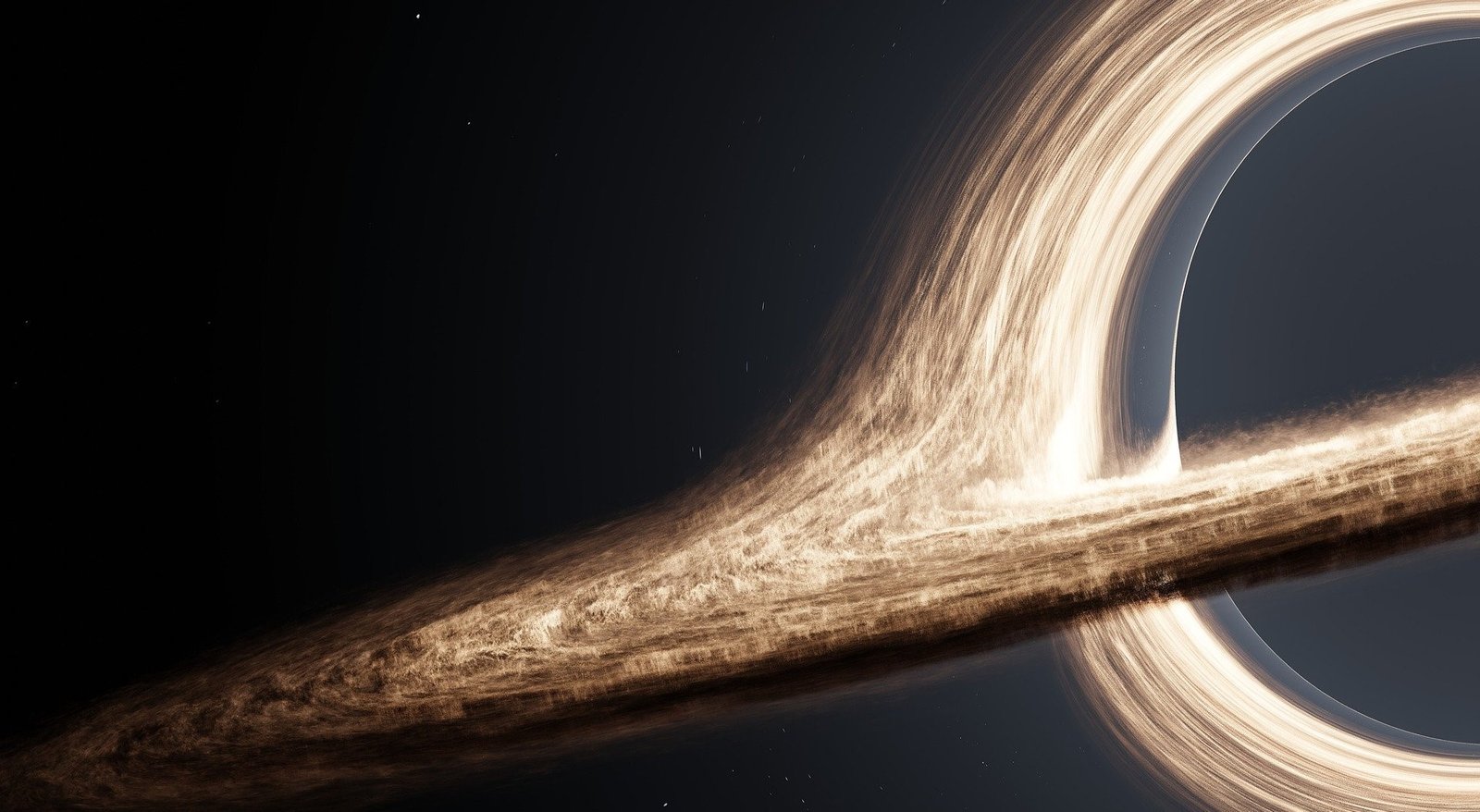The Largest Black Hole Ever Found
What is the largest black hole ever found? Black holes have long fascinated scientists and the general public alike, not only for their mysterious nature but also for their immense gravitational power that can affect entire galaxies. Among these cosmic titans, one black hole stands out as the largest ever discovered. Known as TON 618, this black hole is an astronomical marvel that challenges our understanding of the universe. Let’s delve into what makes TON 618 the largest black hole ever found, exploring its characteristics, significance, and what it tells us about the cosmos.
Understanding Black Holes

Before diving into the specifics of TON 618, it’s essential to understand what black holes are and how they are categorized based on size and mass.
What are Black Holes?
Black holes are regions of space where gravity is so intense that nothing, not even light, can escape from them. This gravitational pull results from a massive amount of matter being concentrated into a very small area, often formed when a massive star collapses under its own gravity at the end of its life cycle.
- The Formation and Characteristics of Black Holes:
Black holes form through processes like the death of massive stars, known as stellar collapse, or through the merging of smaller black holes. They consist of a central singularity, where all the mass is concentrated, and an event horizon, the boundary beyond which nothing can return. - Types of Black Holes: Stellar, Intermediate, and Supermassive:
- Stellar Black Holes: Typically a few times the mass of our Sun.
- Intermediate Black Holes: Ranging from hundreds to thousands of solar masses.
- Supermassive Black Holes: Millions to billions of solar masses, often found at the centers of galaxies.
Measuring the Size of Black Holes
Understanding the size and mass of black holes is crucial for identifying the largest among them.
- Mass, Volume, and Event Horizon:
The size of a black hole is often described in terms of its mass, usually measured in solar masses (the mass of our Sun). The event horizon’s size, or Schwarzschild radius, depends on this mass, marking the point where escape velocity equals the speed of light. - Methods Used to Determine Black Hole Size:
Scientists use various techniques to estimate black hole sizes, including observing the movement of nearby stars, accretion disks, gravitational lensing, and radiation emitted from surrounding gas and dust.
What is the largest black hole ever found? The Largest Black Hole Ever Found
The title of the largest black hole ever discovered belongs to the colossal TON 618. But what makes this black hole so extraordinary?
Introducing TON 618

Location and Discovery:
TON 618 is located in a distant quasar, approximately 10.37 billion light-years away from Earth, in the constellation Canes Venatici. It was first identified in the 1950s through radio surveys and further studied in the 1970s using optical telescopes. The discovery of its supermassive nature occurred when scientists analyzed its spectrum and luminosity, revealing its staggering mass.
Key Characteristics and Mass:
TON 618 is estimated to have a mass of 66 billion solar masses, making it by far the largest black hole ever measured. Its incredible size and luminosity classify it as a hyperluminous quasar, an object that outshines entire galaxies.
Comparison with Other Massive Black Holes
While TON 618 holds the record, it’s part of a list of other massive black holes that have intrigued astronomers:



- Phoenix A: With a mass of around 100 billion solar masses, it’s one of the closest competitors.
- IC 1101’s Central Black Hole: Approximately 40 billion solar masses.
- Holm 15A: Estimated at 34 billion solar masses.
These black holes, while massive, do not match the sheer scale of TON 618, which remains unparalleled in its magnitude.
Exploring TON 618: The Cosmic Behemoth
TON 618’s colossal size and power make it a fascinating subject of study. Let’s explore its location, mass, and influence on surrounding space.
Location and Distance from Earth
TON 618 in the Cosmic Landscape:
Positioned over 10 billion light-years from Earth, TON 618 resides in a remote part of the universe, far beyond the reach of most observable galaxies. Its distance places it in the early universe, providing a glimpse into a time when the cosmos was still young.
How Far is it from Earth?
The vast distance of TON 618 from Earth challenges astronomers in terms of observation and measurement, yet it also provides an opportunity to study black hole formation and growth in the universe’s early stages.
The Enormous Mass of TON 618
Calculating its Mass:
Scientists calculate TON 618’s mass by analyzing the velocity of gas orbiting around its event horizon and the quasar’s luminosity. The immense gravitational pull required to keep such gas in orbit indicates its staggering mass.
Understanding the Scale:
To put TON 618’s size into perspective, it has a mass equivalent to 66 billion Suns. If placed in our solar system, its event horizon would encompass the entire solar system out to the Kuiper Belt, dwarfing our planetary neighborhood.
Event Horizon and Gravitational Influence
The Enormous Event Horizon:
TON 618’s event horizon spans approximately 1,300 astronomical units (AU), where 1 AU is the average distance from the Earth to the Sun. This vast region marks the boundary where light and matter can no longer escape the black hole’s grip.
Effects on Surrounding Space and Matter:
The gravitational influence of TON 618 extends far beyond its event horizon, affecting nearby galaxies, stars, and interstellar matter. Its presence in the quasar contributes to powerful jets and emissions that can shape surrounding cosmic structures.
How Did TON 618 Become So Massive?
The sheer size of TON 618 raises questions about how such a colossal black hole could form and grow to such proportions.
Theories on Black Hole Growth
Accretion of Matter:
One of the primary theories explaining the growth of supermassive black holes like TON 618 is the accretion of matter. As gas and dust fall into the black hole’s gravitational well, they form an accretion disk, emitting energy as they spiral inward and contribute to the black hole’s mass.
Mergers with Other Black Holes:
Another possibility is the merger of smaller black holes over cosmic timescales, leading to the accumulation of mass and the formation of a supermassive black hole. This process might involve the collision of galaxies, where central black holes merge and grow.
TON 618’s Uniqueness
Why is it So Large?
TON 618’s extraordinary size may result from a combination of rapid accretion and merger events in the early universe.
Its quasar status indicates active feeding, where it consumes matter at an exceptional rate, maintaining its luminous output.
The Role of Quasars and Galactic Nuclei:
TON 618 is part of a quasar, an active galactic nucleus with a supermassive black hole at its center. Quasars are among the brightest objects in the universe, and TON 618’s intense luminosity signifies its rapid growth and energy release.
The Role of Supermassive Black Holes in the Universe
Supermassive black holes like TON 618 play a vital role in the cosmic landscape, influencing the formation and evolution of galaxies and the universe itself.
Influence on Galaxy Formation
Central Galactic Engines:
Supermassive black holes often reside at the centers of galaxies, acting as central engines that drive various galactic processes. Their gravitational pull affects star formation, gas dynamics, and the overall structure of galaxies.
Impact on Star Formation:
The energy output from supermassive black holes can regulate star formation by heating and dispersing surrounding gas. This feedback mechanism influences the growth and development of galaxies over billions of years.
Contribution to Cosmic Structure
Black Holes as Cosmic Architects:
Black holes are integral to the cosmic web, connecting galaxies and shaping large-scale structures. Their influence extends beyond their immediate surroundings, affecting galaxy clusters and intergalactic space.
Their Role in the Evolution of the Universe:
Supermassive black holes are key players in the universe’s evolution, contributing to the formation of galaxies, galaxy clusters, and the overall distribution of matter. Understanding their role helps us comprehend the universe’s history and future.
Studying Supermassive Black Holes
Researching supermassive black holes like TON 618 requires advanced technologies and innovative techniques to overcome observational challenges.
Techniques and Technologies
Observational Methods:
Astronomers employ various methods to study black holes, including spectroscopy, radio astronomy, and gravitational wave detection. These techniques reveal information about black hole properties, such as mass, spin, and accretion rates.
Use of Telescopes and Simulations:
Modern telescopes, like the Event Horizon Telescope and Hubble Space Telescope, provide valuable data on black holes. Computer simulations also play a crucial role in modeling black hole behavior and interactions with surrounding matter.
Challenges in Measuring Black Holes
Limitations of Current Technology:
Despite technological advancements, measuring black holes remains challenging due to their distant locations, immense sizes, and the complexity of their environments. Observing phenomena like event horizons and accretion disks requires precise instrumentation.
Future Prospects in Black Hole Research:
Future missions and technological innovations promise to enhance our understanding of black holes. Projects like the James Webb Space Telescope and next-generation observatories aim to uncover new insights into these cosmic giants.
Conclusion
TON 618 stands as a testament to the universe’s grandeur and complexity. Its massive size and luminosity challenge our understanding of black holes and offer valuable insights into cosmic evolution. As scientists continue to explore these enigmatic entities, they unravel the mysteries of the cosmos, deepening our knowledge of the universe and our place within it.
TON 618, the largest black hole ever discovered, serves as a beacon for future research and discovery, reminding us of the boundless wonders that await exploration in the vast expanse of space.
FAQs
- What is the largest black hole ever discovered?
The largest black hole ever discovered is TON 618, a supermassive black hole with an estimated mass of 66 billion solar masses. It resides in a distant quasar and is one of the most massive objects known in the universe. - How was TON 618 discovered?
TON 618 was discovered through radio surveys and optical observations in the mid-20th century. Its quasar status and luminous output led scientists to identify its massive nature, confirming its status as the largest known black hole. - Can black holes grow indefinitely?
Black holes can grow by accreting matter and merging with other black holes. However, their growth is limited by the availability of surrounding matter and potential feedback mechanisms that can regulate their size and energy output. - What is the nearest supermassive black hole to Earth?
The nearest supermassive black hole to Earth is Sagittarius A* (Sgr A*), located at the center of our Milky Way galaxy. It has a mass of about 4 million solar masses and is approximately 26,000 light-years away from Earth. - Could there be larger black holes than TON 618 yet to be discovered?
It’s possible that larger black holes exist in the universe, but they may remain undetected due to their distant locations or unique characteristics. Ongoing research and technological advancements may reveal new findings, expanding our understanding of the cosmos.

